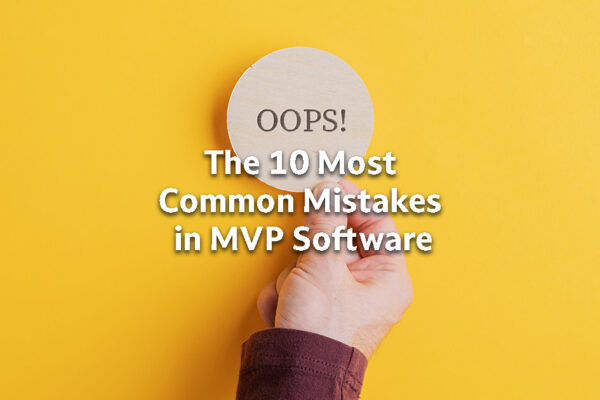10 Common Mistakes in MVP Software Development

Minimum Viable Product (MVP) development is a brilliant way to get your product to market faster. It reduces risk, saves money, and gives you the chance to learn quickly from real users. But just like any smart approach, it’s easy to trip up if you don’t go in with a clear plan. Here’s 10 Common Mistakes in MVP Software Development.
At Back9, we’ve seen businesses get excited about the MVP model—only to hit a wall due to a few common missteps. These mistakes can delay growth, chew through budget, or worse—create a product no one wants.
In this article, we’ll break down the most frequent MVP pitfalls and, more importantly, how to avoid them. Whether you’re a founder, product manager, or marketing lead, these insights can help keep your MVP on track.
1. Confusing “Minimum” with “Mediocre”
Let’s be clear—minimum viable does not mean low quality. It’s easy to misinterpret the term and underdeliver. Some teams cut corners, thinking MVP just means the cheapest or fastest version possible.
But an MVP still needs to solve a real problem for real users. It has to function well enough to gather useful feedback and provide value.
Instead of asking “What can we strip out?”, ask “What’s the smallest thing we can build that people will care about?”
It’s one of the Mistakes in MVP Software. Getting that balance right is key.
2. Building Without a Clear Problem
This one’s more common than you’d think. And one of the most common Mistakes in MVP Software development we see. A lot of MVPs get built based on assumptions, internal ideas, or tech trends—without enough real-world validation.
If your MVP doesn’t solve a pain point your users actually experience, it’s unlikely to gain traction.
Start by talking to your audience. Use surveys, interviews, and even forums to learn what frustrates them. That insight will help shape a product that’s grounded in genuine need.
Always build for a problem, not just a feature set.
3. Overloading the MVP with Features
It’s tempting to try and impress users by adding too much, too soon. But overstuffing an MVP is a trap.
Why? Because every additional feature means more design, dev time, testing, and potential bugs. It also dilutes your focus.
A bloated MVP confuses users and makes it harder to measure what actually works. Keep it lean. Prioritise core functionality—what’s essential to test your idea?
Focus on doing one thing really well. You can always build more later.
4. Skipping UX and UI Design
Just because it’s an MVP doesn’t mean it can look or feel clunky. Poor user experience is a fast way to lose early adopters.
Your product doesn’t need to be pixel-perfect, but it does need to be usable and intuitive. Clean design builds trust. Even small UX details—like clear buttons or an easy onboarding flow—can make or break first impressions.
A great MVP balances functionality with usability. Don’t leave design as an afterthought.
5. Ignoring Feedback (or Collecting the Wrong Kind)
The whole point of launching an MVP is to learn. But that only works if you actively seek—and act on—feedback.
Some teams either don’t collect feedback at all, or they ask the wrong questions. Vague comments like “It’s good” or “Needs work” won’t help you improve.
Instead, ask focused questions:
- What did you try to do, and did it work?
- What confused or frustrated you?
- What feature do you wish it had?
Track usage metrics too. Tools like Hotjar, Microsoft Clarity, or GA4 can help reveal what users actually do—not just what they say.
6. Treating the MVP Like a Final Product
Another big mistake? Thinking the MVP is the end goal.
It’s not. It’s the start of a longer journey.
If you treat your MVP like the finished product, you may fall into the trap of polishing features instead of learning. Or you might avoid making necessary changes for fear of “breaking” what you’ve already built.
Keep the mindset flexible. The MVP should evolve based on data, not personal attachment.
7. Failing to Define Success
You’ve built and launched your MVP—great! But how do you know if it’s working?
Too many MVPs launch without a clear set of success metrics. Without defined goals, it’s impossible to know if you’re heading in the right direction.
Set benchmarks early. These could include:
- Number of signups or purchases
- Activation rate (how many people actually use the product)
- Retention after 7 or 30 days
- Feedback quality or NPS
Tracking these indicators helps inform what to change, what to keep, and when to move on to the next phase.
8. Not Communicating Internally
Building an MVP often happens fast—and sometimes, too fast for teams to stay in sync.
When goals aren’t clear internally, teams pull in different directions. Marketing might push features that dev hasn’t finished. Sales could promise things the product doesn’t support yet.
Regular check-ins, a shared roadmap, and alignment on what “done” looks like will save everyone time and energy.
Also, be honest about what’s not included yet. Set realistic expectations with both your team and your users.
9. Skipping the Launch Strategy
You’ve got your MVP ready. But now what?
Some businesses put everything into building the MVP and forget about how they’ll launch it. The best product in the world still needs a proper intro.
Even a soft launch should be planned. Identify early adopters, create an onboarding experience, and make it easy for users to give feedback.
If no one uses your MVP, it’s just a prototype—no matter how good it is.
10. Giving Up Too Early
Not every MVP takes off straight away. That’s normal. In fact, some of the most successful products today started with a messy, underwhelming first version.
The key is iteration. Use the data, tweak your approach, and keep improving.
An MVP is only valuable if you keep going after launch. Don’t expect instant success. Expect to learn, adapt, and grow.
Final Thoughts
Building an MVP is one of the smartest moves a business can make—but only if it’s done right.
Avoiding these common mistakes can save you time, budget, and headaches. It’ll also give your product a better shot at success. Remember: MVPs are about learning fast, staying lean, and evolving with purpose.
If you’re working on an MVP or thinking about launching one, keep it focused. Make it useful. And most importantly, stay curious. But most importantly, avoid these 10 Common Mistakes in MVP Software Development!
Got a project you’re exploring? Let’s talk—Back9 is here to help you bring smart digital ideas to life.




